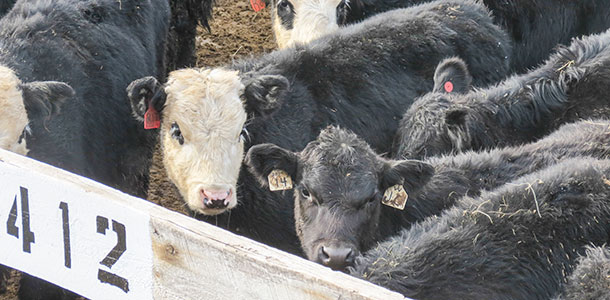That prognosis may sound like career suicide for a vet. But to Hilton profits follow healthy animals, and that’s good for everybody, especially the calves.
Research from Iowa State years ago established that the average profitable calf made a feedlot owner $52.45 per head, but when it was treated just once for sickness, the calf took a loss of $15.16.
“So we step back 66 dollars by treating a calf one time in the feedlot,” Hilton said. “When it really gets ugly is when the calf is treated twice or more; it’s a loss of $137.30. So it’s 190 dollars behind the calf that stays healthy.”
Speaking at the NCBA Cattlemen’s College in San Antonio on Feb. 4, Hilton outlined the practical management steps making the most difference in calf health – starting with the nutritional foundation for the cow and the calf.
Hilton said growing research in nutrigenomics provides more data proving early nutrition in the womb strengthens the calf’s outlook. When small problems arise for a calf, if a nutritional pattern is established, the animal will stay health.
“Seventy-five percent of the growth in the calf growth happens in the last two months of gestation, but the placenta develops early, practically immediately,” Hilton said. “Some research shows if you have a dam that has decreased nutrition early in first month of gestation, it can impact that fetus development of (the calf’s) lungs and make him more likely to have bovine respiratory disease 18 months later.”
Colostral quality and quantity adds to that immunity outside the womb, Hilton said, as calves with higher total protein and higher colostrum ingestion are shown to be “three times less likely to have BRD in the feedlot.”
Giving calves the right start is harder in many states where spring calving actually occurs in winter. A nutritioned calf can hit the ground, jump up and take colostrum faster. But Mother Nature is working against the animal in winter months, Hilton added.
Other key factors to a sound calf start follow.
Vaccination programs
Hilton says there’s no single plan that can be applied to a vaccination program. But the danger is made worse by underestimating new cattle coming into an operation.
“Most of you don’t mean to, but how you get disease in your farm is: You pay good money for it. It doesn’t sneak in the back. It sneaks in the front when you open that trailer and put that animal into your pasture that you didn’t quarantine.”
A consistent program should include two doses of modified-live vaccine. Useful options include a first vaccination at 2 months and a second at weaning, or one at nine weeks pre-weaning and another at weaning.

Weaning stronger calves
The weaning stage may be more critical than the vaccination, Hilton said, as shown by studies at Oklahoma State that vaccinated some calves but didn’t wean them while weaning another group without vaccinations.
Weaned calves that received no vaccinations “performed better and were healthier in the feedlot than the other ones that weren’t weaned but got vaccinated,” Hilton said. “So the most important thing is to wean the calf; most would say 45 days is what we need to get that calf really healthy.”
Hilton added another study out of Iowa showing calves weaned for more than 30 days saw only 13 percent sickness, compared to those not weaned seeing 30 percent. The same study showed cattle with modified-live vaccines being treated at 18 percent, and those with killed vaccines seeing treatment 30 percent.
Parasite programs
Confusion about parasitic control products is a frequent question among producers Hilton meets, due in part to the changing studies on parasite drugs.
“Parasite programs should be followed, but methods and products can be confusing,” he said. “Research has varied on how to use or rotate products. As a veterinarian, I’ve been told five different things in 31 years.”
Pour-ons are less reliable than injectable products and oral drenches, he said. And most producers treat once a year, typically more in spring than fall.
“I’m a low-medicine vet – and I want to use management instead of money and medicine.”
Calving environment
If the goal is zero sickness, Hilton said, the right start at calving is critical.
“I have herds that have been on a records program for 15 years and never had a sick calf between birth and weaning. Never.”
Hilton drew a comparison between human births, saying new parents don’t ever let a nurse take a newborn child into a bassinet when the previous infant had shed sickness in it.
“But that’s OK when we calve cows. We calve in the same area, where bacteria virus and crypto just build up, and we wonder why calves get sick.”
He says he’s a big believer in the Sandhills calving system, where new pairs stay in a pasture and cows who haven’t calved move to a new one after a week. After several weeks they can be commingled.
By separating cows from heifers, you have three times the protection against spreading disease, Hilton said. “That one thing will eliminate a lot of disease. Heifers just don’t have the immune system and the breadth of immunity that a cow does.”
Paid through preconditioning
Hilton said producers aren’t just leaving money on the table when they don’t precondition calves; they’re creating more headaches down the road for the feeder. And that hurts themselves in the long run.
A pre-conditioned calf is especially more efficient toward the last week of the feeding. Noting the high correlation between average daily gain and profit per head, the goal will be to get cattle gain 3 to 3.5 pounds a day to boost profitability. And a study Hilton led showed it reaped $174.30 to precondition a calf.
“2014 was the biggest no-brainer in history to pre-condition your calves,” Hilton said, due to cheap feed and high priced calves. “Next year could be even better yet.” ![]()
PHOTOS
Photos by Progressive Cattleman staff.








